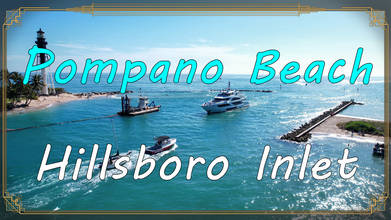
Hillsboro Inlet / Lighthouse / Beach - Pompano Beach, Florida
- almost 3 years ago
- 1.5k VŪZ
11 




- 22
- Report
Hillsboro Point was designated as hazardous for the safe navigation of ships in 1855 and federal designation was sought. A request for a lighthouse at the inlet was first made in 1884. The request was repeated yearly and rejected 17 times. In 1901, the United States Lighthouse Board persuaded Congress to authorize the construction of a lighthouse in the dark area between Jupiter Inlet Light and Fowey Rocks Light. The official order approved on February 12, 1901, called for a "first-order light at or near Hillsboro Point...at a cost not to exceed $90,000." No appropriation of funds was made in 1901 and in 1902 $45,000 was appropriated. The full funding to build the lighthouse was appropriated on March 3, 1903. Initially a site on the south side of the inlet was selected, however it was not feasible, so a site on the north of the inlet was chosen. The owner of the property did not want to sell at first but after beginning condemnation proceedings, an agreement to purchase the land was reached. The 3 acre (1.2 ha) parcel was purchased for $150 from Elnathan T. Field and Mary W. Osborn of Middleton, New Jersey who had bought the land for 70 cents an acre (0.4 ha) from the Trustees of the Internal Improvement Fund.
Soon after the light was operational unexplained reports of fires in the Everglades began to come in. The cause was the lens, when stopped in the morning at just the right position, it would focus the sunlight west towards the wetlands. A landward baffle was installed. This also shielded nearby residents from the bright light at night.
Lightkeepers would assist shipwrecks using three 12 to 20 horsepower gas boats. The wives of the lighthouse keepers would make sea grape jelly to trade for pickled vegetables from local farmers. Four Coast Guard signalmen were stationed at the lighthouse in World War I barracked in one of the storehouses.
During the 1926 Miami hurricane J.B. Isler stood a 32-hour watch, keeping the light burning while fearing the lighthouse would fall. It stood but 20 feet (6.1 m) of sand was washed out from under it, according to Mary Ella Knight Voss, daughter of a prior lightkeeper. The storm also damaged the dwellings and carried away the boathouse and wharf. Isler's son George and daughter Ruth, born in the keeper's house, were the first children of record born at the Hillsboro Inlet.
The lighthouse beach patrol spotted a German U-boat in 1943, during World War II. The submarine was reportedly sunk, but no wreck has been documented. Later that year a freighter, the M.S. Arcura aroused the suspicion of a lighthouse keeper. The ship was being used as a raider and was crewed by German nationals and carrying arms. The crew were transported to Port Everglades and the Arcura became a war prize.
In 1974 the lighthouse was fully automated. One United States Coast Guardsman was assigned to remain on site to maintain the light and grounds. The assistant keepers' homes were converted to guest quarters for senior coast guard and other senior military officers. The Hillsboro Inlet Light Station was listed on the U.S. National Register of Historic Places on February 16, 1979. The lighthouse and buildings are little altered from their original construction in 1907.
In the second half of the 20th century, this inlet became an increasingly busy waterway. Hillsboro Inlet Light is considered one of the most powerful lights in the world with a beam that can be seen for 28 nautical miles (52 km; 32 mi).
Music from Uppbeat (free for Creators!):https://uppbeat.io/t/andrey-rossi/flash-saleLicense code: 8LVAOABZA16R7P7M
Hillsboro Inlet Light - Wikipedia
Up Next
Southeast Florida ShowReel - "The Best of" Locations [4K]
- David L
- 1.9k VŪZ
9 - 16
- over 2 years ago
Pompano Beach, Florida - What a stunning beachfront ! [4K]
- David L
- 1.9k VŪZ
14 - 22
- about 4 years ago
Jupiter Inlet & Dubois Park, Florida USA - The Perfect Beach and Water Location!
- David L
- 2.1k VŪZ
2 - 2
- over 3 years ago
Boynton Beach Inlet, Florida - A Beach and Boater's Delight
- David L
- 2.0k VŪZ
5 - 6
- about 3 years ago
[Mini] Back to the Island (Peanut Island) - Amazing Aerial View!!
- David L
- 1.9k VŪZ
1 - 1
- over 3 years ago
[Mini] Tropic Tide - The Ghost Ship of the Port of Palm Beach
- David L
- 1.6k VŪZ
3 - 6
- over 3 years ago
Boca Raton Inlet, Florida - Where Relaxation Meets Beauty ! [4K]
- David L
- 2.4k VŪZ
19 - 24
- almost 4 years ago
City of Jupiter, Florida - Thinking of visiting? Then you will want to watch this stunning video!⛱️
- David L
- 1.1k VŪZ
10 - 13
- 3 months ago
Haulover Beach / Inlet / Sandbar - The "Salt Life" Adventure
- David L
- 1.4k VŪZ
4 - 6
- 4 months ago
Heavenly Bliss Awaits at Juno Beach, Florida USA😎🌴
- David L
- 1.5k VŪZ
3 - 5
- over 2 years ago